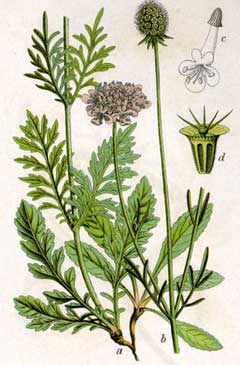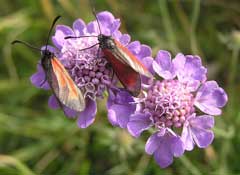 |
|
http://commons.wikimedia.org/wiki/File:Scabiosa_columbaria_Sturm3.jpg |
 |
|
Translate this page:
Summary
Bloom Color: Blue, Lavender. Main Bloom Time: Early summer, Early fall, Late summer, Late spring, Mid summer, Mid fall, Mid spring. Form: Spreading or horizontal.
Physical Characteristics

 Scabiosa columbaria is a PERENNIAL growing to 0.8 m (2ft 7in) by 0.8 m (2ft 7in) at a medium rate.
Scabiosa columbaria is a PERENNIAL growing to 0.8 m (2ft 7in) by 0.8 m (2ft 7in) at a medium rate.
See above for USDA hardiness. It is hardy to UK zone 6. It is in flower from July to September, and the seeds ripen from August to September. The species is hermaphrodite (has both male and female organs) and is pollinated by Bees, Lepidoptera (Moths & Butterflies).
It is noted for attracting wildlife.
Suitable for: light (sandy), medium (loamy) and heavy (clay) soils. Suitable pH: mildly acid, neutral and basic (mildly alkaline) soils and can grow in very alkaline soils.
It cannot grow in the shade. It prefers dry or moist soil.
UK Hardiness Map
US Hardiness Map
Synonyms
Plant Habitats
Meadow; Cultivated Beds;
Edible Uses
Edible Parts: Leaves
Edible Uses:
Leaves[177]. No more details are given.
References More on Edible Uses
Medicinal Uses
Plants For A Future can not take any responsibility for any adverse effects from the use of plants. Always seek advice from a professional before using a plant medicinally.
None known
References More on Medicinal Uses
The Bookshop: Edible Plant Books
Our Latest books on Perennial Plants For Food Forests and Permaculture Gardens in paperback or digital formats.

Edible Tropical Plants
Food Forest Plants for Hotter Conditions: 250+ Plants For Tropical Food Forests & Permaculture Gardens.
More

Edible Temperate Plants
Plants for Your Food Forest: 500 Plants for Temperate Food Forests & Permaculture Gardens.
More

More Books
PFAF have eight books available in paperback and digital formats. Browse the shop for more information.
Shop Now
Other Uses
References More on Other Uses
Cultivation details
Landscape Uses:Border. Prefers a neutral or alkaline soil and a sunny position[200]. Succeeds in ordinary garden soil[1]. Grows well in a dry sunny meadow[200]. The flowers are a good nectar source for bees and lepidoptera, the plant is also a good food source for the caterpillars of many butterfly species[200]. This species name is sometimes treated as the group name for an aggregate of species[200]. Members of this genus are rarely if ever troubled by browsing deer[233]. Special Features:
Attractive foliage, Not North American native, Naturalizing, Attracts butterflies, Suitable for cut flowers, Extended bloom season in Zones 9A and above, Attractive flowers or blooms.
References Carbon Farming Information and Carbon Sequestration Information
Temperature Converter
Type a value in the Celsius field to convert the value to Fahrenheit:
Fahrenheit:
The PFAF Bookshop
Plants For A Future have a number of books available in paperback and digital form. Book titles include Edible Plants, Edible Perennials, Edible Trees,Edible Shrubs, Woodland Gardening, and Temperate Food Forest Plants. Our new book is Food Forest Plants For Hotter Conditions (Tropical and Sub-Tropical).
Shop Now
Plant Propagation
Seed - sow spring in a cold frame. The seedlings are subject to damping off[1] so water with care and make sure to give adequate ventilation. Prick out the seedlings into individual pots once they are large enough to handle and plant them out into their permanent positions in the summer. Division in spring. Larger divisions can be planted out direct into their permanent positions. We have found it best to pot up the smaller divisions and grow them on in a lightly shaded position in a cold frame, planting them out once they are well established in the summer.
Other Names
If available other names are mentioned here
Native Range
TEMPERATE ASIA: Iran, Turkey, Azerbaijan, Russian Federation (Dagestan), Turkmenistan EUROPE: Denmark, United Kingdom, Sweden, Czechoslovakia, Austria, Belgium, Switzerland, Germany, Hungary, Netherlands, Poland, Russian Federation (European part), Belarus, Estonia, Lithuania, Latvia, Moldova, Ukraine, Former Yugoslavia, Albania, Bulgaria, Greece, Italy, Romania, Spain, France (incl. Corsica), Portugal AFRICA: Algeria (north), Morocco, Eritrea, Ethiopia, Kenya, Tanzania, Uganda, Cameroon, Democratic Republic of the Congo, Mozambique, Malawi, Zambia, Zimbabwe, Botswana, Lesotho, Namibia, Eswatini, South Africa
Weed Potential
Right plant wrong place. We are currently updating this section.
Please note that a plant may be invasive in one area but may not in your area so it's worth checking.
Conservation Status
IUCN Red List of Threatened Plants Status :

Growth: S = slow M = medium F = fast. Soil: L = light (sandy) M = medium H = heavy (clay). pH: A = acid N = neutral B = basic (alkaline). Shade: F = full shade S = semi-shade N = no shade. Moisture: D = dry M = Moist We = wet Wa = water.
Now available:
Food Forest Plants for Mediterranean Conditions
350+ Perennial Plants For Mediterranean and Drier Food Forests and Permaculture Gardens.
[Paperback and eBook]
This is the third in Plants For A Future's series of plant guides for food forests tailored to
specific climate zones. Following volumes on temperate and tropical ecosystems, this book focuses
on species suited to Mediterranean conditions—regions with hot, dry summers and cool, wet winters,
often facing the added challenge of climate change.
Read More
Expert comment
Author
L.
Botanical References
17200
Links / References
For a list of references used on this page please go here
Readers comment
| Add a comment |
|
If you have important information about this plant that may help other users please add a comment or link below. Only comments or links that are felt to be directly relevant to a plant will be included. If you think a comment/link or information contained on this page is inaccurate or misleading we would welcome your feedback at [email protected]. If you have questions about a plant please use the Forum on this website as we do not have the resources to answer questions ourselves.
* Please note: the comments by website users are not necessarily those held by PFAF and may give misleading or inaccurate information.
To leave a comment please Register or login here All comments need to be approved so will not appear immediately.
|
Subject : Scabiosa columbaria
|
|
|
|